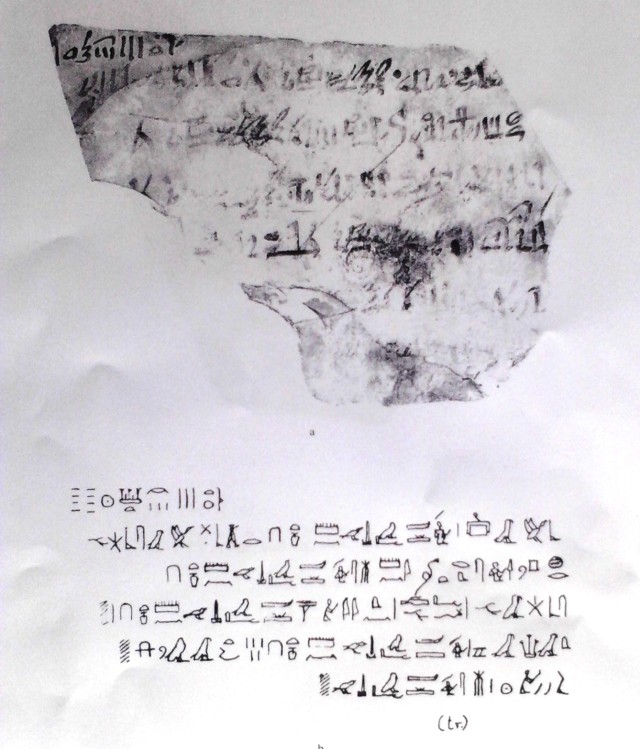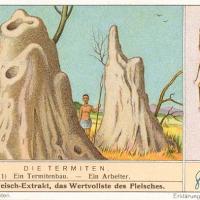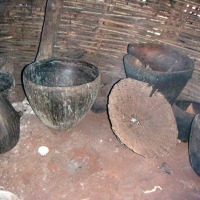Although there are many tomb drawings and small models representing agriculture, kitchen activities and banquets, knowledge of specific ways by which food was prepared is practically non-existent. As N. Millet commented:
An area of ancient Egyptian life about which we are poorly informed is that of food preparation; no cookbooks have survived (if there ever were any) to cast light upon the art of the kitchen…

As depicted here, the growing and processing of grapes was considered a central agricultural activity. Source: Tomb of Nakht, west wall, in Gourna.

Processing grapes. Fifth Dynasty tomb of Ptah-hotep at Saqqara. Source: unknown
However, as discussed below, there are little snippets about food and agriculture that are contained in the hieratic inscriptions found on ostrica. Ostrica are shards of pottery that, throughout the millenia, were used as a readily available paper substitute to record a wide variety of information, which provide little windows into daily life of the times. The writing usually was in hieratic – a cursive form of hieroglyphic.
The ostracon discussed below is a receipt for various services rendered, written during the reign of Ramses II* by a residence of the workers’ village of Deir el-Medina, which is located across the river from Luxor. The text records payment for services rendered – all payment being in jars of what is thought to be vinegar ( HmD):
![]()

The ancient egyptian workman’s village “deir el-medina”, where the workers from the Valley of the Kings lived, across the river from modern Luxor (Photo credit: Wikipedia)
A rendering of the inscription:
Regnal year 3, third month of the Inundation season, day 8* Payment for the door: 10 mnt-jars of vinegar to Basa To the village magician, Amunmose: 10 mnt-jars of vinegar [Payment for] one door, one box: 11(?) mnt-jars of vinegar to Kenymin [Payment for] a mat: 15 mnt-jars of vinegar, to Kaha The w’rtw-official Ramose: vinegar… …

Hieratic ostracon 906.20.6 Recto, photo and transcription. Courtesy of the Royal Onterio Museum. Source: Millet, “Vinegar at Deir el-Medinah”
As queried by N. Millet – is this really vinegar, and if so, what was it used for? It is quite a lot of vinegar paid to individuals. He has two suggestions: First, that it is actually soured wine, which still could be drunk by residents of the village. Second, it is vinegar, used possibly for pickling of vegetables. The date of the ostrica (September) would be during the harvesting of vegetables and thus a time for pickling fresh produce.
A difficulty, however, with this interpretation is that the word thought to be vinegar – HmD – is not recorded elsewhere in written records save at the end of a list of various kinds of wine (in the Onomasticon of Amenemope) – at least at the time of Millet’s article (1999).
Hence, payment was perhaps in sour wine – though I do think that Millet’s suggestion of vinegar to pickle vegetables is intriguing.
Questions regarding the meaning of the word HmD – sour wine or tasty condiment – demonstrate the difficulties of resurrecting a past language. In this case, a word that is found only twice in all the thousands of written remains from ancient Egypt. Egyptologists, in a philological bend, have termed words occurring only once or twice a ‘hapax legomenon‘:
…[This] is a lovely technical term for a word that appears once in a body of text: a hapax legomenon (plural: hapax legomena), Greek for “once said.” The term comes from philology, the study of old texts.
Source: Steven Pinker, Words and Rules, 2000, page 172
If any readers of this entry have further information on HmD, I would be delighted to learn. It is sobering (though not surprising) to see scores of articles and books about the existence and use of vinegar in ancien Egypt – none (except Millet’s article, that I’m aware of) that base their information on real data.
Main source for this article:
N.B. Millet, “Vinegar at Deir el-Medina,” in: Gold of Praise: Studies on Ancient Egypt in Honor of Edward F. Wente, ed. by Emily Teeter and J.A. Larson. Chicago, Oriental Institute, 1999.
——-
For Blog entries about food and related topics see:
-
Botanical Studies – Ancient Egypt
-
The Ancient Egyptian Negative Confessions: Agriculture and Cuisine
-
Nutsedge – perhaps the oldest managed ‘weed’ in Predynastic Egypt
-
Cuisines and Crops of Africa – The Lotus Eaters of Central Africa
-
Ancient Egyptian Magical Spells Appropriate for Banquets
-
An Ancient Egyptian ‘Recipe’ – for curing urinary ailments
-
Roast Pigeons and Homemade Beer – Ancient Egypt
-
Herodotus on Food in Egypt
-
The Ancient Egyptian Negative Confessions and Cuisine
-
A Greedy Ancient Egyptian Bureaucrat who Loved Fat
Related articles
- Modern Words that Survive from Ancient Egypt – What, How and Why (dianabuja.wordpress.com)
- Botanical Studies – Ancient Egypt (dianabuja.wordpress.com)
- How did Ancient Egyptians Keep Warm in The Winter? – A possible answer (dianabuja.wordpress.com)


























I needed to show this blog post, “Vinegar in Ancient Egypt: Sour Wine or Tasty Condiment?
| DIANABUJA’S BLOG: Africa, the Middle East, Agriculture, History & Culture” along with my friends on facebook itself. I reallyjust sought to spread ur great publishing! Many thanks, Marlys
LikeLike
Thant’s fine – and thanks very much!
LikeLike
Pingback: The Lunch Box of Priestess Henutmehyt, Her Eternal Workers, & Her Final Demise | DIANABUJA'S BLOG
Excellent posts!!
LikeLike